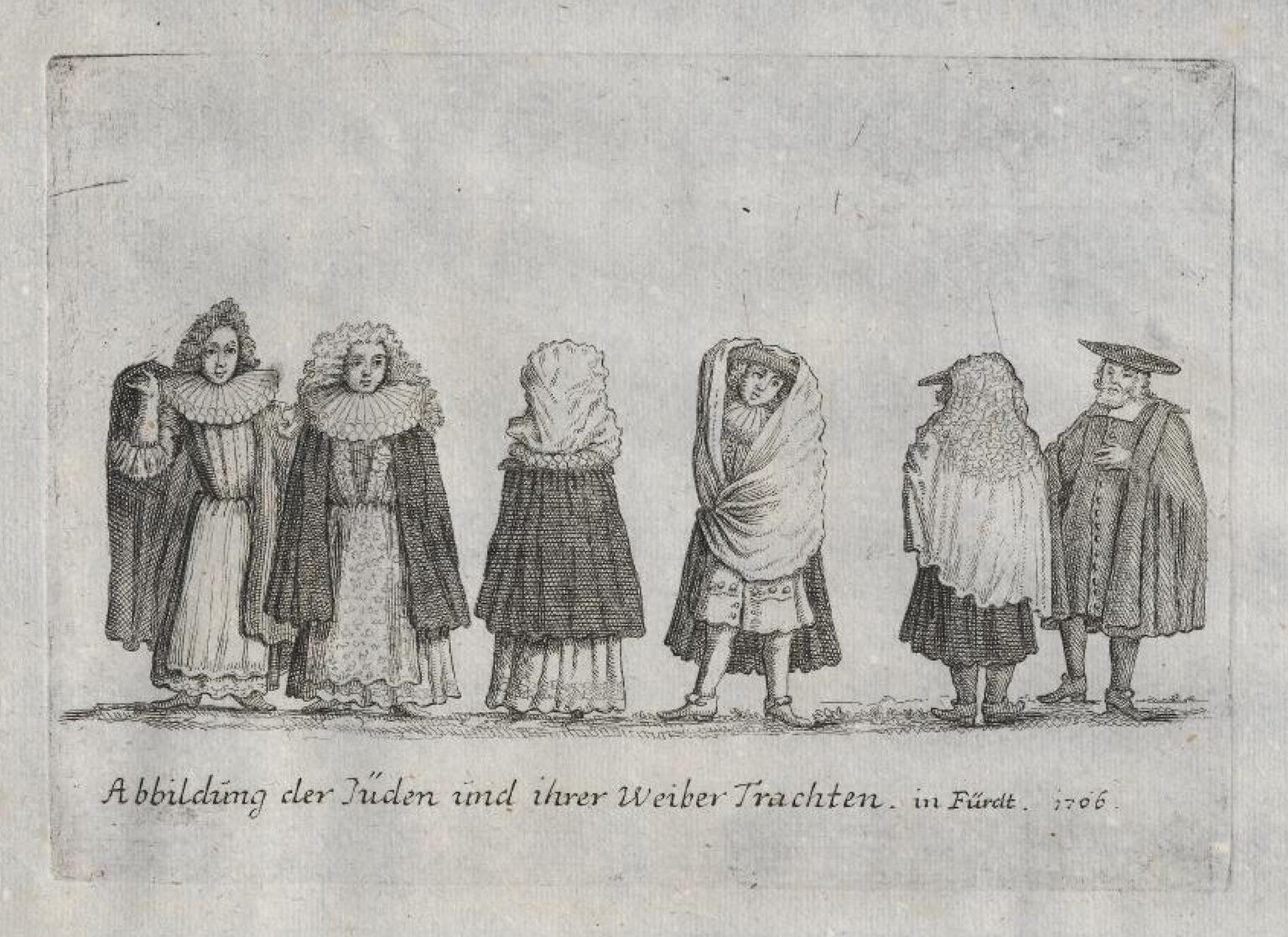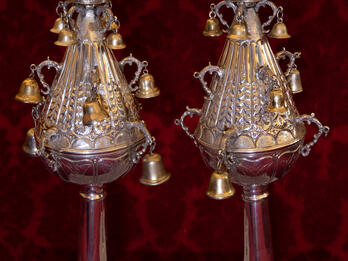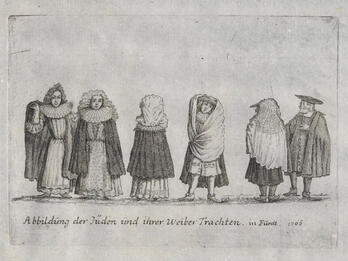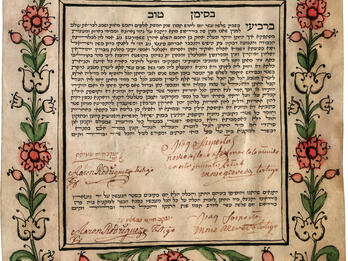Takkanot Fiorda (Regulations of Fürth)
Clothing Regulations
1. A head of household, student, or youth—be he local or a foreigner, whether he eats for free, or pays for his food—may not wear a camisol [vest] of gold cloth or brocade with silver or gold flowers, neither on the sabbath nor on a holiday or work day. (And those who already own one are nevertheless not allowed to go around in it, much less to have new ones made. Whenever someone transgresses, he must give two reichsthalers to charity: should he refuse to pay, there are ways to force him.)
2. One may not order a new mantel [synagogue overcoat] or any other overcoat to be made of damask. (However, those who already own one are permitted [to wear it] when celebrating a circumcision or attending one as godfather or marrying off a child.)
3. No unmarried person may wear a silk overcoat; those who already own one may wear it on the Sabbath and holidays. (But on the Sabbath, when he is bringing gifts to the bride, he may wear a newly made silk overcoat; also, no head of family may wear a silk overcoat on workdays.)
4. Henceforth no head of household may wear a rock [velvet coat]1 that he is having newly made or is buying used, but if he already owns one he may wear it. However, on the Sabbath, he must wear a mantel over it so that the coat cannot be seen. (Similarly, whoever is wearing a damask coat on a holiday must wear his mantel over it.) [ . . . ]
7. Those who are wearing a wig and are forced to go to the synagogue in it may not have it powdered.
8. From now on, no head of household may wear a silver clasp on his mantel, and those who do not remove it from their mantel within four days must give three reichsthalers to charity.
9. Henceforth no ornaments are allowed on the talles [tallit] other than those made of white satin, damask, silver embroidery, or gold cloth—everything else must be white. In addition, one may not wear a talles made of silk on the holy Sabbath (and if he is a boy, taking on the Law, the talles and the ornament in the middle must be white—those who already own [an adorned] one may wear it.)
10. One must be able to recognize people by their clothing and must thereby be able to distinguish students from other people and servants. For that reason, the children of our community—if they be students, as well as strangers who are students—should wear collars. The children of our community who transgress [this ordinance] may not apply for a title.2 The students who are strangers [i.e., non-locals] lose their free meals.
11. One may not wear a red Roquelaure cloak3 even if it is of a different color, neither here nor in Nuremberg.
12. One may not help oneself to snuff or to whole Presil-tobacco,4 neither in the old nor in the new nor in any other synagogue—the penalty is four reichsthalers for charity. [ . . . ]
Clothing for Women and Girls
13. No woman may order to have made a golden veil or sternlein [forehead kerchief],5 interwoven with stars, or [adorned] with pearls; or fashionable caps of gold cloth, [caps] embroidered in silver or gold, or adorned with silver flowers. (Those who already own something of that kind are forbidden [to wear it] on the Sabbath and holidays, and even more so during the week, except when they stand as godmothers, or accompany a bride or a new mother to the synagogue, or when their son is thirteen years and one day old. Those who transgress must pay first two reichsthalers, then four reichsthalers and finally eight reichsthalers as penalty.)
14. Henceforth women and girls may not wear clothes made of velvet, gold cloth with an ornamental border, or with flowers of silver or gold, be they woven or embroidered. Regarding those who already own such [items], only the women mentioned in §13 are permitted to wear them. Girls, however, are only permitted [to wear them] when a brother or sister is getting married. It is not permitted to have them newly made or to buy them.
15. A woman may wear an overcoat made of damask on a holiday but not on the Sabbath. The above-mentioned penalty applies. (Those who already own one and have been wearing it on the Sabbath may continue to wear it until it is worn out.)6
16. Women and girls are prohibited from wearing hoopskirts, similarly nachtzeige7 and even more so fontanges,8 pinned up manteaux, long contouches, and adriennes;9 as well as shoes and slippers that are embroidered, adorned with good or poor silver, with gold or with ribbons—they may be only of black or dyed leather. The above-mentioned penalty applies.
17. Women and girls are prohibited from wearing pearls, Kartelsteine10 or other pendants, and bracelets and buckles with good stones. Similarly gold chains and gold belts that are studded with diamonds. Henceforth, they may not have such things made but those who already own them are permitted to wear them on the days mentioned in §13.
18. Women are permitted to wear rings, but girls are not. Both are permitted to wear earrings, but they may not cost more than fifty reichsthaler. But if a bride receives something valuable from her groom, she may wear it until her wedding day.
19. Neither women nor girls may go into the street in aight coat—it may be worn at home, but it may not have lace. Corsets, however, are also forbidden at home, because it is a shameful habit when no other clothes are worn on top.
Notes
[A rock is a shorter coat than a mantel—often mid-thigh length, like a long blazer—worn over a vest (camisol), which is worn over a shirt.—Trans.]
[I.e., if you want to be addressed by your titul (title) and enjoy whatever privileges come with that title, you need to dress distinctly like all those who share that distinction. Scholars were to wear a collar—students a small collar, and ordained rabbis a large collar.—Trans.]
[Roquelaure is knee-length cloak that is usually red.—Trans.]
[Presil is a type of tobacco popular in Bavaria. Most likely a dark, uncut tobacco imported from Brazil.—Trans.]
[Sternlein means either “little star” or (as a backwash from Yiddish shterntikhl) a type of elaborate kerchief that covers the forehead. Though shterntikhl makes sense grammatically, it is unclear if women in Fürth in the mid-eighteenth century were wearing this sort of headgear, which is generally recognized as coming into vogue at the end of the century.—Trans.]
[Veraltet could also mean “out of fashion.”—Trans.]
[Meaning unclear. Nachtzeug are ladies’ bedclothes, but these would not be worn in public, and thus, unlikely to be mentioned in these regulations.—Trans.]
[Fontagen: an elaborate hairdo supported by staves and ribbons.—Trans.]
[Manteau is a top skirt fastened at the waist with loosely falling back pleats. The Contouche and Adrienne are French dresses without a marked waist whose back, unpleated, falls freely over a hoop.—Trans.]
[Meaning unclear.—Trans.]
Credits
Published in: The Posen Library of Jewish Culture and Civilization, vol. 5.







